31/8/2010
Czech Photography Today in Tokyo
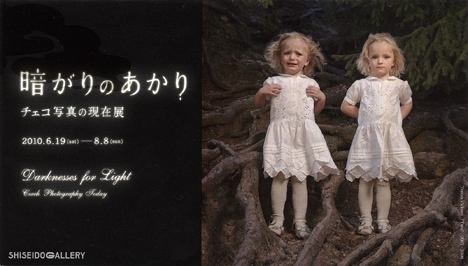 |
Darkness for Light. Czech Photography Today.
Shiseido Gallery, Tokyo, June 16 – August 8, 2010.
Photographers Vladimír Birgus, Václav Jirásek, Antonín Kratochvíl, Michal Macků, Dita Pepe, Ivan Pinkava, Rudo Prekop, Tono Stano, Jindřich Štreit, Tereza Vlčková. Curators: Keiko Toyoda and Yu Iseki. Catalogue in Japanese and English, 104 pages, praface by Helena Koenigsmarková, text by Vladimír Argus and Kotaro Iizawa.
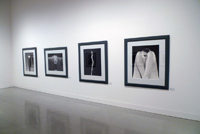 |
| Photographs by Tono Stano |
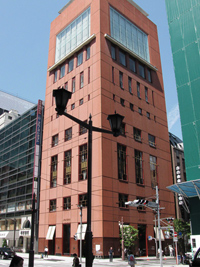 |
| Shiseido Gallery in Tokyo (building by Ricardo Bofill) |
 |
| Václav Jirásek, Brothers, 1998 |
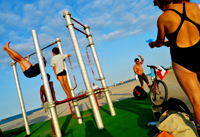 |
| Vladimír Birgus, Barcelona, 2009 |
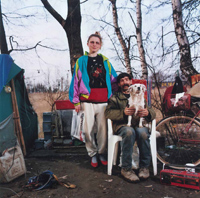 |
| Dita Pepe, from the Selfportraits with Men series |
Darkness for Light – Czech Photography Today took me by surprise, and I’m not afraid to admit it. So much so, that even though I’d intended to write about it right after visiting last week, I wanted to let my ideas sit for a while before attempting to do it justice. At the risk of gushing, it is likely the best group photography show I’ve seen this year, and if you know nothing about Czech photography (and I did not) Shiseido Gallery is in a position to enlighten you.
There is one Czech photographer that I was familiar with prior to Darkness — the hermit outsider-artist Miroslav Tichy, whose homemade cameras and voyeuristic street photos probably didn’t set the best precedent for me. But Tichy, in all his quirkiness, is not represented here. Instead we are given a wide range of work, from the documentary to the near-erotic, with a strong dose of the avant garde, that tells me that I need to add new names to my list of favourite artists. There are ten featured photographers — more than I’m willing to take on in a single article. But I’ll cover the ones that jumped out at me:
In her “Two” series Tereza Vlčková does “cloned” photos of children, where a single child has been photographed in two different places against the same background — essentially beside herself — and the images are superimposed so that there appear to be two identical twins in a single shot. Seeing twins in any case is unusual, but here it is difficult to escape the sense of something unnatural. Taken outdoors, there is a fairy-tale feeling to the works and a sense that perhaps two moments of the same person can, in fact, represent two entirely different people. And the strangeness of the situation is abetted by the doll-like perfection of the girls Vlčková has chosen for her images.
Michal Macků has done a number of photos using a developing technique that allows him to manipulate the negative as it develops — a form which he uses to make the figures appear to be tearing themselves apart, or to make the same image appear over and over in slightly different forms. They’re more than just tricky; they’re powerful and full of motion.
Powerful, too, are Tono Stano’s studio works with models. My small beef with Stano’s work is that it is more or less your basic erotic coffee-table-book photography. That said, it is by no means your usual erotic photography. Stano manages to create images using body position and shadow that look like nothing you’ve ever seen before. They are truly stunning images. And the ones shown here are fairly tame.
In contrast to Stano’s overtly masculine approach is Dita Pepe, who’s series “Self-portraits with Men” is precisely that — the artist herself posed with various men in staged photos where she blends in with their lives and surroundings, dressing and posing as if the life depicted were her own. The viewer is left to realize that not only is she using the men and their lives as props, but that we are left unconsciously evaluating her “relationship” to these random men despite the fact that there is no relationship between them at all. What does it mean to pose “with” a man? And whose photo is it, when the photographer is also the impostor? Pepe gives Cindy Sherman a run for her money.
Ivan Pinkava’s works here are wonderful, but perhaps a little disappointing. The majority of shots shown at the exhibition are still-lifes and studies which, although rich and beautiful in their spare detail, do not seem particularly representative of Pinkava. Only one more typical photo greets the visitor, on the way down the stairs. Pinkava is known mainly for working with bodies and incorporating certain classical poses, images and characters into his work. But his models are frequently androgynous, difficult to read, or exaggerated. In a show that is, after all, a kind of “greatest hits” for Czech photography, it’s a bit surprising not to see more of his work with people.
Rudo Prekop does studio work incorporating people and found objects, largely back-lit leading to strong silhouettes and shadow-play. There is a certain air of the surreal to his work, with a deliberately unpolished appearance. He wants to show you the strings, but remember the light.
Finally, Vladimír Birgus’s work at first made me snort. I hated the overblown, unnatural colours. But as the show went on, I kept coming back. Birgus’s shots from various mundane public spaces in a variety of cities kept drawing me in, and eventually I realized it was because of how successful he has been at capturing the space without focusing on the people. Each image has a number of passers-by, none of whom seem to fall into the focal point of the image. All seem peripheral, unconnected, incidental. And the vibrant colours bring out the sidewalk, the steps, the city square. They are photographs of place like no other, and remarkably unique. And perhaps this comes as something of an irony, or else a deliberate distancing device, since Birgus’s earlier work dealt with feelings of alienation within the city. These works are almost meditative.
The show is nicely laid out as well, with more standard documentary-style works from Jindřich Štreit and Antonín Kratochvíl at the entrance, moving on to the more conceptual works in the gallery’s back room, and larger and more studio-based works in a walled-off space to the right. There is a sense of moving almost logically through the many personalities and approaches of these photographers, without requiring a beginning and end. Instead, you circle back to the start, richer for the experience.
Owen Schaefer
(from Tokyo Weekender No. 27/2010)
.

